Beyond the Ranger Factory: Warner College of Natural Resources
A CSU @ 150 Story by Nikki Martinez published May 4, 2020Colorado State University’s commitment to preserving Earth’s natural resources started with its first forestry course in 1904. The class was offered in response to an impassioned paper, “The importance of a forest school in Colorado,” published earlier that year by William Stone of the Colorado Forestry Association.
Stone detailed how demand for wood from the Rocky Mountains had skyrocketed as towns and cities and railroads suddenly appeared across the open land of the young state. He grieved at the rate at which these forests were being lost, stating that planting and repairing wooded lands needed “men” skilled in forestry – but there were few of them to be found.
In quick response, the Colorado Agricultural College rose to the challenge by initiating the first forestry course to address a complex natural resource issue in its home state. Today, that commitment and urgency toward maintaining natural resources remains a primary effort of what is now known as the Warner College of Natural Resources at Colorado State University.
In its 116 years, Warner College has grown and adapted to reflect global changes and trends in natural resource consumption while also contributing to the foundation of natural resource knowledge.
“At Warner College, we’ve challenged ourselves to create departments, programs and centers that address the critical natural resource issues facing society,” said John Hayes, who has been dean of the college since 2014.
CSU @ 150 stories
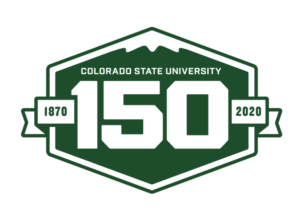
Read more stories about the Warner College of Natural Resources in this series celebrating the 150-year history of Colorado State University.
Ed Warner lends his name – and passion – to CSU’s College of Natural Resources
A forestry legacy connects generations
It’s only natural – Michael Smith Natural Resources Building welcomes Warner College Rams
Warner College’s five departments uniquely address natural resources issues across the bounds of scientific discipline spanning the biological, social and physical sciences. The College evolved alongside society’s use of and social orientations toward natural resources.
The early 20th century: Conservation in a young nation
“Conservation means the wise use of the earth and its resources for the lasting good of men.”
— Gifford Pinchot, first head of the U.S. Forest Service
The beginning of the 20th century brought Gifford Pinchot’s ideas of conservation and wise use to a young, industrializing nation. The origins of the Division of Forestry and Range Management at CAC – today’s Warner College – coincided with the origins of the conservation movement; in fact, Colorado was the first state in the nation to include the principles of forest conservation in its constitution, and its first forest reserve was set aside from development in 1891 on the White River Plateau.
1904 Forest and Rangeland Stewardship | A Yale-educated botanist named Burton O. Longyear became the department’s first professor in 1904 and later head of the official Department of Botany and Forestry in 1909. Longyear would prove to be a model of the department as he became the first state forester in 1912. In 1924, the department started “Foresters Days,” and it is still celebrated today – albeit now known as “Natural Resource Days” – making it an almost 100-year tradition.
Since then, the department has excelled in research and education in forestry, rangeland ecology and management, fire science and restoration ecology. Keeping in line with the first forestry course as a response to Colorado deforestation during westward expansion, the department’s resources address modern natural resource issues. The Colorado Forest Restoration Institute works to restore and enhance the resilience of forest ecosystems. The Western Forest Fire Research Center innovates approaches to Colorado and the nation’s most pressing fire management issues.


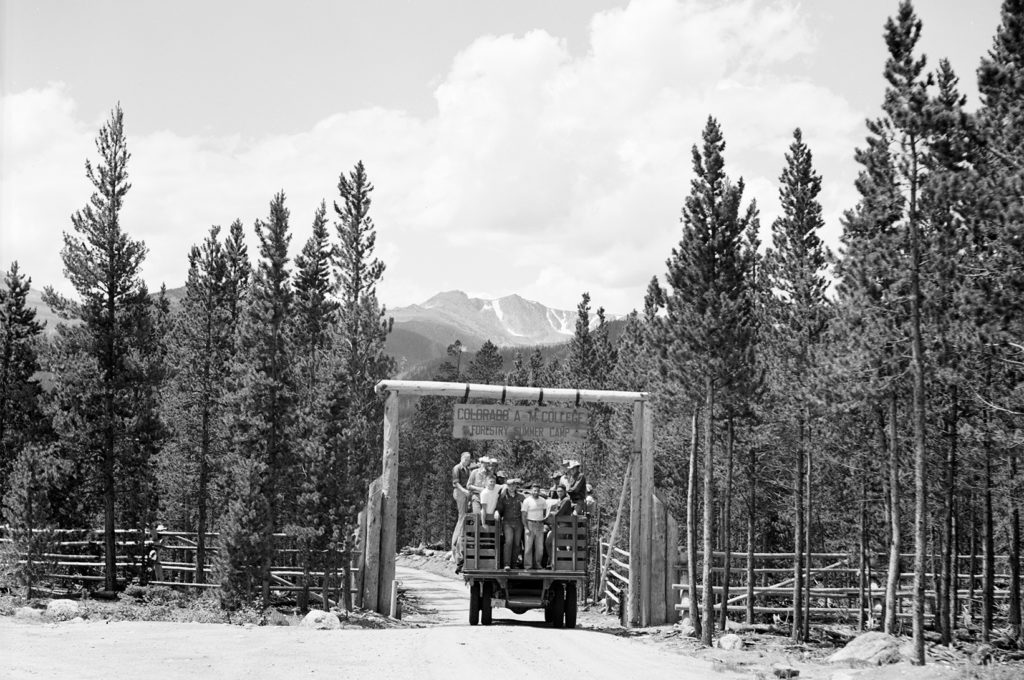
1914 The Mountain Campus | In August 1914, CAC President Charles A. Lory traveled to Pingree Park to locate a proposed forest lodge and to select a number of land tracts for use as study areas for the forestry classes and for experimental purposes in forestry. The Pingree Park Forest Lodge was constructed the next fall. By 1927, forestry students were required to attend Pingree Park Forestry Camp, a four-day packing trip covering camp construction, cooking, firefighting and trail construction.
Renamed the CSU Mountain Campus in 2015, the facility has seen hundreds of natural resource students pass through each summer, providing the experiential learning opportunity originally envisioned in 1914.
1923 Geosciences | Geology got its start after a fire gutted the former Chemistry Building in 1922. During the fire, the collection of rocks and minerals that had been stored in the attic plummeted down into the debris in the basement. A few days later, President Lory called Major Roy G. Coffin of the Chemistry Department into his office and asked him if he would like to teach some geology, starting with recovering the rock collection. Coffin accepted it as a challenge — one that he kept until he retired 25 years later.
What is now the Department of Geosciences has established a wide breadth of groundbreaking research from environmental to economic geology. Led by Department Head Rick Aster, faculty research expertise in seismology has been called upon often over the years when earthquakes hit the nation… The department also excels in alumni mentorship and donorship. In fact, the college is named for graduate Edward M. Warner.
1930s-1950s: Natural resources for economic purpose
“In some instances, forests were deliberately fired to provide dead, dry poles, or for the convenience of sheep herders, or even to provide a spectacle.”
— W.J. Morrill, professor of forestry, Colorado A&M
Throughout the first half of the 20th century, Americans valued natural resources for economic and human-related benefits – wood to build houses and railroad ties, fish and game to hunt, rangeland to support livestock, and minerals and oil for energy.


Students in the 1950s.
1947 Fish, Wildlife, and Conservation Biology | The department started in 1947 as the Department of Forest Recreation and Game Management; the department Head was JVK Wagar, namesake of the Wagar building on the CSU Oval where the department is currently located. The “Game Management” name was reference to wildlife. In that same year, the Colorado Cooperative Wildlife Research Unit was formed, which has evolved into the Colorado Cooperative Fish and Wildlife Research Unit housed within the department in partnership with the U.S. Geological Survey.
Since, the department has churned out students prepared for careers in conservation and management of game and non-game species, computer modeling and analysis of habitat suitability and global patterns of migratory wildlife. The department garnered global attention with significant innovation in wildlife population dynamics under late researcher David Anderson and Ken Burnham among others. The Department was also among early adaptors of the concepts of human dimensions of natural resources with regard to wildlife and habitat conservation.
The 1960s on: Natural resources and non-economic value
“A conservationist is one who is humbly aware that with each stroke of the axe he is writing his signature on the face of the land.”
— Aldo Leopold, author of the Land Ethic of Conservation
Beginning in the 1960s, many Americans began to value natural resources for their non-economic values such as wilderness, clean air and water, and endangered species. During this time, CSU’s College of Natural Resources became a pioneer in integrated, system approaches to natural resources education, research and outreach.


Students in the 1960s and 1970s participating in recreational activities.
1967: Human Dimensions of Natural Resources | While the department has roots in the forest recreation and game management department that was developed in 1948, in 1967 the Department of Outdoor Recreation formed, taking into account uses of natural resources for outdoor recreation. The department became known as the “Ranger Factory,” as many of its graduates secured positions as rangers in federal and state park systems across the United States. In 1968, the department acquired the Poudre River bottomland, a property that would evolve into CSU’s Environmental Learning Center. By 1972 the department began sending students to study abroad. It was the first at CSU to develop a study abroad program and the first department to offer this opportunity to students across the U.S. majoring in recreation, parks and tourism.
Since, the 212-acre ELC has continued to provide opportunities for faculty and students to conduct fieldwork, experiential education, and research. The department has also offered the first graduate degree delivered entirely in another country at Central China Normal University, which is its Masters of Tourism Management.
The new millennium: Sustainability and diversity
“The land-grant mission was a great starting point, but it has not met all of its goals in creating equal opportunity for all perspectives. To live up to that promise, we must allow diversity and inclusion to permeate our programs.”
— John Hayes, dean of the Warner College of Natural Resources
In the new millennium, natural resource education retained the guiding notions of conservation but expanded to include principles of sustainable development, community-based stewardship, environmental sustainability and restoration.
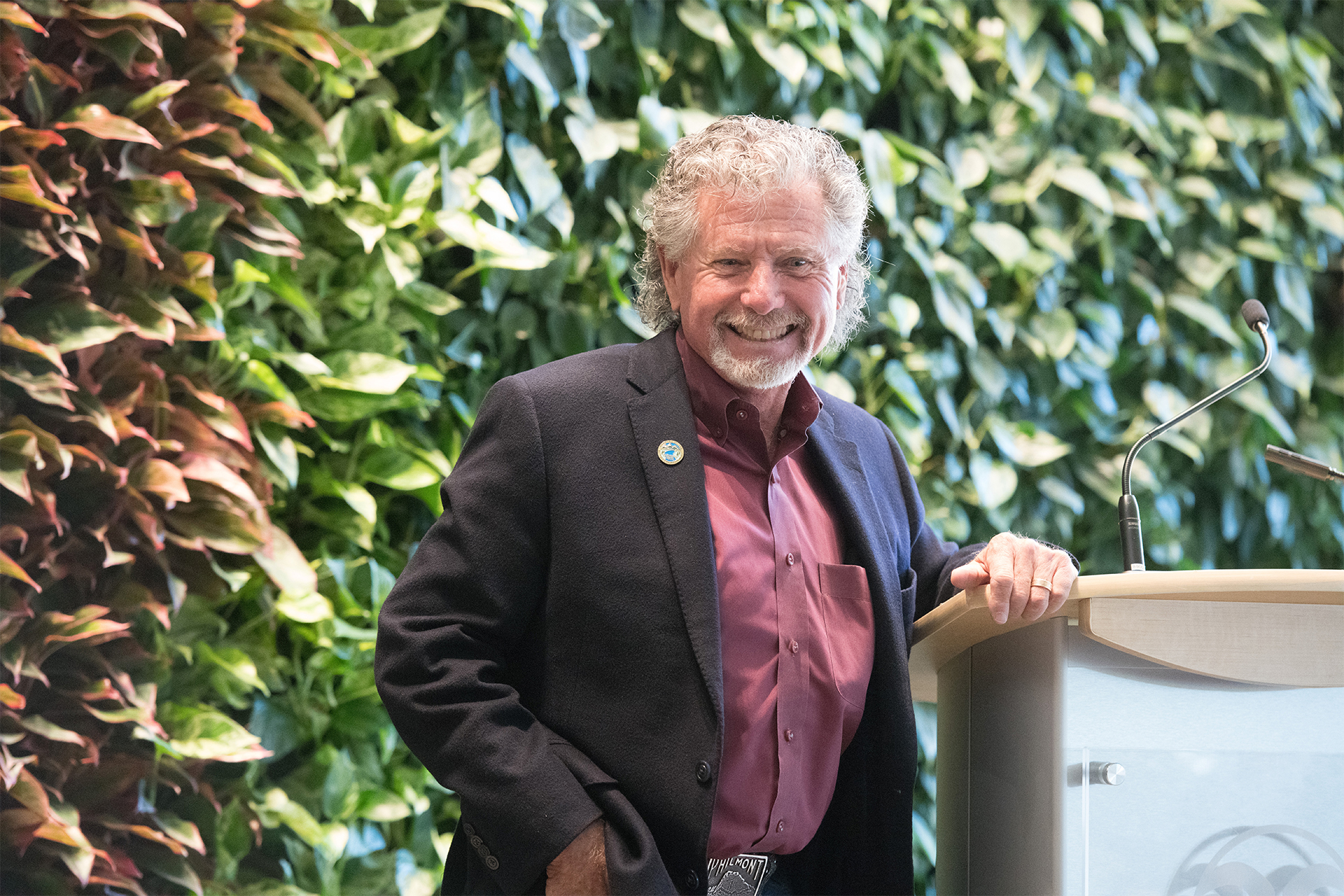
Edward M. Warner
2005 The naming of Warner College | In 2005, Edward M. Warner, a 1968 geology graduate, conservationist, entrepreneur and philanthropist made a donation to the college of $30 million. At the time, it was the largest single donation by an individual to CSU and the largest ever to a natural resources college. The College of Natural Resources was renamed the Warner College of Natural Resources in 2006.
2011 Ecosystem Science and Sustainability | The newest department at Warner College, the Ecosystem Science and Sustainability department grew from pioneering efforts around ecosystem science through the Natural Resource Ecology Laboratory, part of the college since 1967. Over 40 years later, there came a demand to train practitioners in ecosystem science, which spurred the creation of the department. The department is joined with the Watershed Science program, which was originally part of the Department of Forest and Rangeland Stewardship.
The department remains the only program in Colorado that focuses exclusively on scholarship and discovery in the area of ecosystem science and sustainability. Moreover, NREL scientists including Keith Paustian, Dennis Ojima, Kathleen Galvan, Stephen Ogle and Vern Cole received Nobel Peace Prize recognition for their work on the International Panel on Climate Change in 2007.
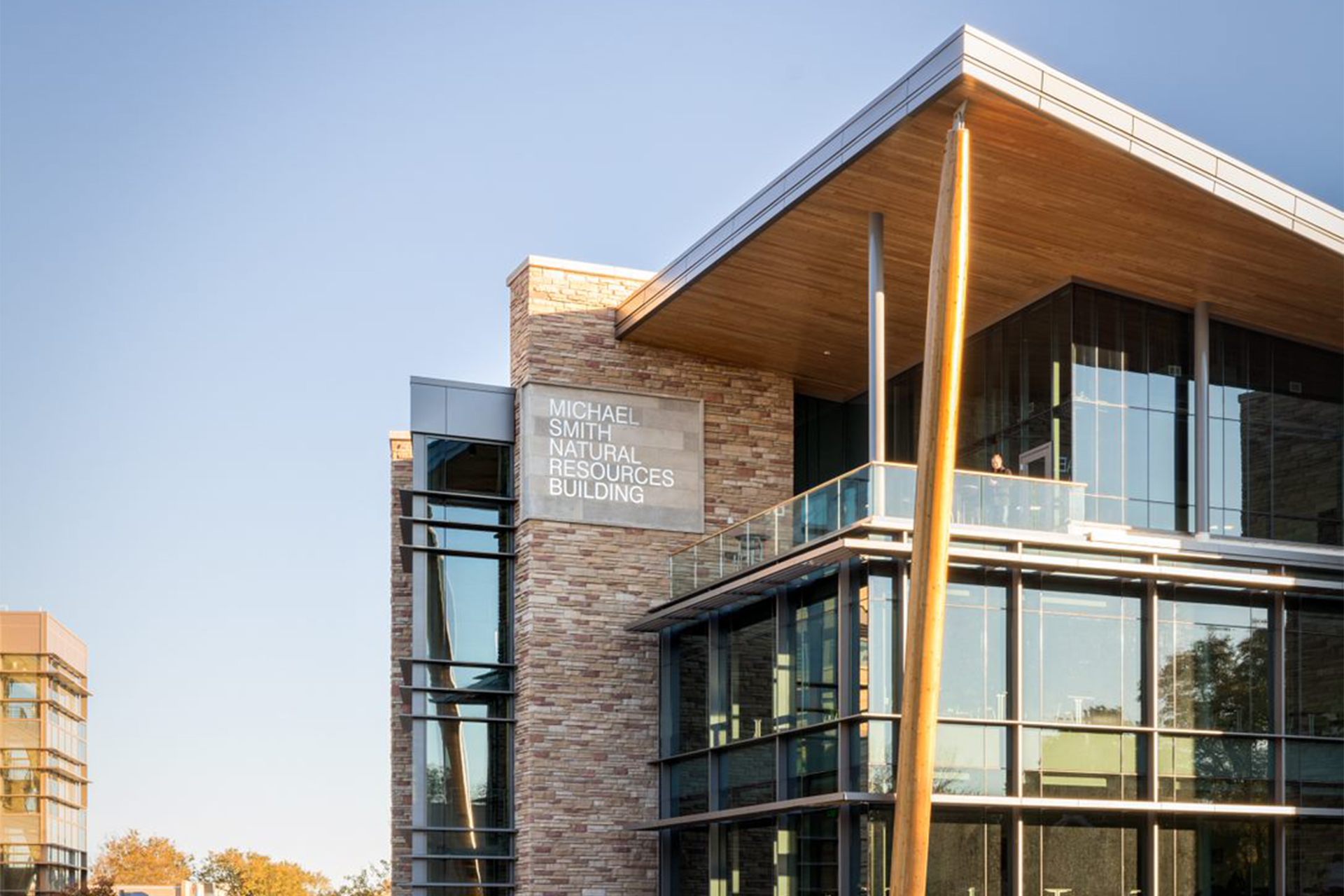
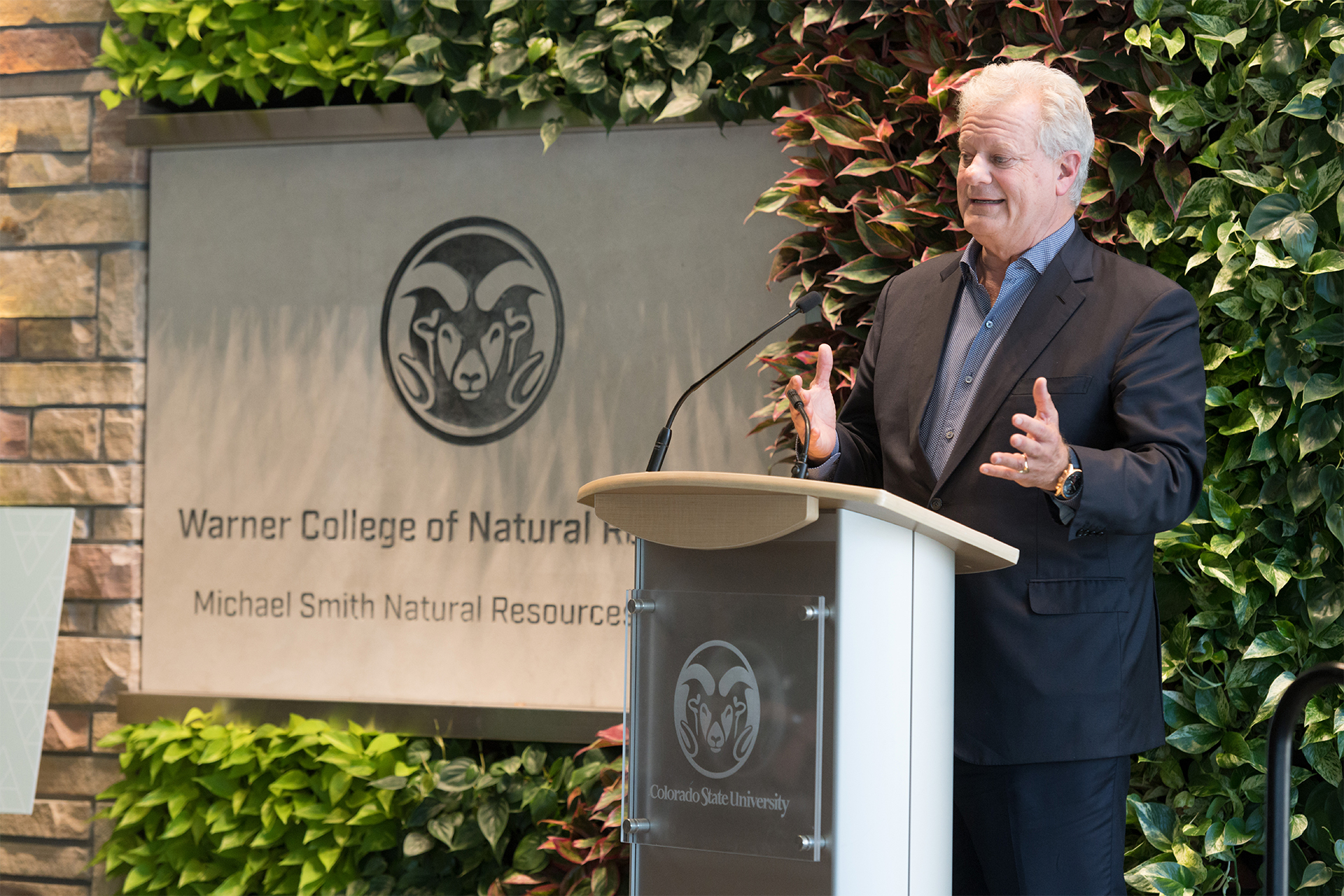
Michael Smith speaks at the dedication of the Michael Smith Natural Resources Building during homecoming in 2018.
2016: Michael Smith Natural Resources Building | Warner College debuted its new, student-centric building in 2016 that includes a 50,000-square-foot addition to the existing building. Energy entrepreneur Michael Smith gave the final critical donation to begin construction, and the building now bears his name. His $13 million gift also included funding for 10 full-tuition scholarships in the Department of Geosciences.
2019: Diversity and inclusion | In 2019, Warner College appointed Dr. Rickey Frierson as its first director of diversity and inclusion. Frierson’s prior research addressed factors underlying degree success by minority males in predominantly white institutions. His arrival set in motion ideals set forth in the strategic plan Dean John Hayes had created in 2015, one of which was diversity and inclusivity as a goal.
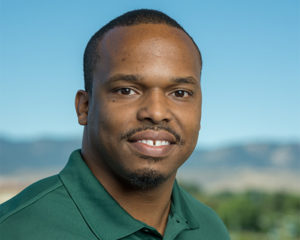
Rickey Frierson
“Natural resources affect us all, but the landscape of who studies the subject has been limited,” Frierson said. “My role here is to help reframe who is our common natural resources professional. The idea is to expand that narrative.”
That same year, the college announced the appointment of new faculty members, researchers and instructors who are working at the intersection of natural resources and minority or underserved populations.
2020: Warner College, COVID-19 and distance learning
On March 23, 2020, in response to the international crisis created by COVID-19, CSU President Joyce McConnell moved all university operations, teaching and learning to online and virtual services for the remainder of Spring semester. While it is a unique academic challenge, Dean Hayes also sees the natural resource perspective.
“The world will be a different place when we make it through this,” he said. “For now, we see differences in the environment as we’ve stayed at home. Air quality has improved in some places with human absence. It’s short term, but it has provided us with perspective about our effect on the Earth.”
In looking to the future, Hayes looks back to the college’s history and longstanding ability to adapt to change.
“We must maintain the relevance of our programs to the evolving demographic of our changing nation and world,” he said. “That is the key to our future.”
Frierson similarly envisions a Warner College of the future with diverse voices, signaling a paradigm shift within the natural resource field.
“I envision Warner College in the future as a world summit of differing backgrounds and perspectives,” Frierson said. “I see a think-tank of people who have the collective goal of maintaining the environment for all people, for wildlife and for the health of the planet.”
The Warner College of Natural Resources at Colorado State University works to solve critical environmental and natural resources issues throughout Colorado and around the world via cutting-edge research and outreach and innovative, comprehensive natural resources education.
Story contributors: Mary Guiden, Rob Novak and Karina Puikkonen